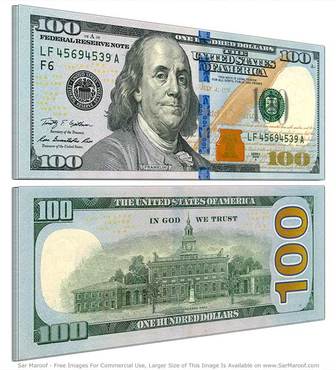It did not give me the option of what denomination bill I wanted but just thrust the hundred-dollar bill at me. It then beeped in annoyance that I wasn’t quicker on the draw, and then was done with me.
Since when have ATMs stocked hundreds? I ask.
I remember the hundred-dollar bill as a reference point in the distant and mysterious world described by the rap music of the late 1990s, music we were all exposed to. Rappers used the word ‘Benjamin’ to refer to hundreds (“It’s All About the Benjamins,” circa 1997-1998; they were implicitly bragging about dealing drugs, which fueled a high-life with hundred-dollar bills, drug earnings, flowing freely).
This puts the hundred-dollar bill way outside any mainstream use for people of my generation or older. Getting this hundred-dollar bill at the ATM leads me to ask whether this social prejudice has changed; are people born in the 2000s, now in K-12 schooling, going to be much less prone to this prejudice against the ‘Benjamin’? Or will an emergent anti-cash prejudice reinforce the anti-hundred prejudice?
An anecdote. An eight-year-old me: enthusiastic about doing well in 2nd grade, involved in speculation with others about whether ghosts inhabited the boys’ bathroom at school, keen to play soccer at ‘recess’ after lunch, and a daily rider of the school bus with many peers. A character called Hosmann, a friend at the time, rode the same bus. Hosmann, on the bus one day, produced a hundred-dollar bill out of his backpack. He proudly showed the bill off to other students, including me.
Second-grade students, of course, don’t even carry cash beyond something like a dollar and a few coins for school cafeteria lunch money. Hosmann was of Bolivian origin. He had odd turns-of-phrase in English (he would say “twist” instead of “turn”). How did he procure this hundred-dollar bill? I presume he pilfered it from home, from his mom, to show off to his peers. Why did he think it a great idea to flash it around on the school bus? A bad sign for where he was headed in later years. I recall his tendency to giggle at everything. I recall him giggling whenever a student saw the hundred that day, which he kept half-concealed in his backpack.
This little experience, around the middle 1990s, made such an impression on the eight-year-old me that I still remember it. A hundred-dollar bill! It may as well have been an artifact from the lost city of Atlantis. I remember criticizing Hosmann to other students at the time for this recklessness.
I cannot remember much else about the school-bus experience from that year. This experience stands out. (Side anecdote: The only other thing I can now clearly pull out of my memory about that year’s school bus is Oscar the Bus Driver, Hispanic, perhaps Salvadorean, a fat man always keen to joke around with students. He acquired the endearing nickname “the Garbage Man” among the student-passengers, which he didn’t mind. This came from a game he would play in which he or students would point to someone outside on the sidewalk or street and say “That is you in the future!” He would give as good as he got. It must have been that once a student was playing this game when a garbage truck came around at an (in)opportune time; the nickname stuck.)
According to the Bureau of Labor Statistics’ inflation calculator,
- $100 in October 1957 equals $870 today (October 2017).
- $100 in October 1977 equals $400 today.
- $100 in October 1997 equals $150 today.
- $100 in October 2017 equals less than four hours of work (gross pay) for the average worker ($25/hour in 2015).
So maybe our anti-hundred-dollar-bill prejudice should be discarded as an anachronism.

